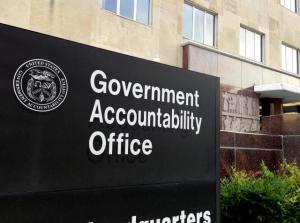

The Government Accountability Office said it received more than 2,600 protests in fiscal 2018, which was less than a 1 percent increase over 2017.
Best listening experience is on Chrome, Firefox or Safari. Subscribe to Federal Drive’s daily audio interviews on Apple Podcasts or PodcastOne.
The Government Accountability Office’s latest annual report on bid protests shows a less than a 1 percent increase in the number of complaints last fiscal year. In the hundreds of thousands, if not millions, of contract transactions that happen annually across government, contractors decided to take their grievances to GAO for just over 2,600 of them.
On the surface, it seems like the federal procurement marketplace is doing just fine.
But if you dig deeper into GAO’s numbers, there are some concerning trends.
 Steve Schooner, a Nash and Cibinic professor of Government Procurement Law at the George Washington University in Washington, D.C., said the number of hearings GAO is holding is so small it may be sending a chilling message to the community.
Steve Schooner, a Nash and Cibinic professor of Government Procurement Law at the George Washington University in Washington, D.C., said the number of hearings GAO is holding is so small it may be sending a chilling message to the community.
“Indeed, based on the 2018 numbers, one must conclude that, under GAO’s current bid protest shop leadership, a significant policy decision has been made to permit fewer hearings or, in effect, eliminate them in all but the most extraordinary matters,” Schooner said in an email to Federal News Network. “To put the 2018 number — hearings in only five cases (only 1/2 of one percent of the matters filed) — in context, keep in mind that the report, which shows a decreasing trend line, only goes back 5 years. But looking at prior reports that number is down from 61 cases (10 percent) in 2010, and 74 cases (13 percent) in 2003. That’s a pretty dramatic change in practice.”
Schooner said GAO changed its policy in 2018 in its 10th edition of its “Descriptive Guide” to bid protests, but didn’t explain well why they are moving away from hearings. That “makes the sudden drop seem out of character or, more specifically, inexplicable.”
He said the guide reminds us that GAO can hold a hearing on its own initiative or provide one upon request.
“Where the guide explains that a protestor may request a hearing and ‘must explain … the reason a hearing is necessary to resolve the protest,’ it doesn’t say that such a hearing will only be granted in ‘extraordinary’ cases,” he said. “I don’t know how much attorneys should be expected to read into the statement: ‘Because hearings increase the costs and burdens of protests, GAO holds hearings only when necessary.’ Rather, GAO merely points out that ‘GAO has issued a number of decisions that discuss reasons for holding hearings …’ And, of course, GAO reserves the right to hold a more limited hearing than requested. But that’s a far cry from statistically, empirically never holding a hearing. Again, none of this is new, so it would be helpful if GAO was more transparent on its obviously evolving practices with regard to hearings.”
It’s more than just the lack of hearings that show some concerning trends. Other procurement lawyers say companies are more inclined to submit protests and GAO’s decision to require a $350 fee per filing doesn’t seem to be a disincentive.
Eric Crusius, a partner with Holland & Knight in Washington, said a mostly steady or rising effectiveness rate is fueling the additional protests.
“When contractors see that a protest will have a 50 percent chance of receiving some kind of relief, they are encouraged their claims will receive a fair hearing,” he said. “It also shows how necessary the protest system is. Federal contracting needs protests to ensure taxpayer dollars are being spent correctly and at nearly 50 percent of the time when a protest is filed, the agency could have done something better.”
Barbara Kinosky, managing partner of Centre Law and Consulting LLC, said she is seeing companies who have not protested before filing complaints.
“I think it’s budget uncertainty at the agency level. Companies are not sure when [the] next big request for proposals will come out,” she said. “There are not a lot of agencies stepping up and making big statements other than GSA about contracting actions or plans.”
Crusius said the numbers also show agencies and vendors are beginning to dig in more. GAO said the sustain rate dropped to 15 percent from 17 percent, but the number of protests going the full 100 days increased to 622 last year from 581 in 2017.
“Once a protest passes the comments stage — when a contractor responds to an agency report and underlying procurement record — on day 40, there is little incentive to resolve the protest,” he said. “For both the government and contractors, the only work left to be done is usually at GAO. GAO has been working to utilize alternative dispute resolution (ADR) in recent years to break the post 40-day logjam. Perhaps looking to expand that program would result in fewer written decisions. That being said, final decisions are helpful from GAO because they help shape future actions by contractors and contracting agencies in similar situations.”
The number of ADR cases increased by five to 86 in 2018 but the success rate dropped considerably to 77 percent from 90 percent in 2017.
Another interesting statistic is the number of protests of task order contracts increased by 100. In 2018, only 356 of the more than 2,400 cases GAO closed came from task orders, up from 256 in 2017, but down from 375 in 2016.
Kinosky said this is one area where vendors remain hesitant to file protests. Unlike single award solicitations, the contractor expects to have many more opportunities to win work so suing their customer over one task order isn’t necessarily a good idea.

In May, the panel made four major recommendations to change bid protests, including limiting viable protest grounds and expediting protest timelines to 10 days for some complaints.
Crusius said expedited protest procedures specifically for smaller dollar protests is worth pursuing and could eliminate a lot of the delays.
“More transparency in procurement and the protest process will encourage more judicious outcomes. For instance, fuller debriefings should be encouraged because they would sharply curtail protests that are filed in the search of additional information,” he said. “In addition, greater public access to GAO protest dockets and documents will help contractors and their attorneys make more informed decisions about when to protest. The protest process (as well as the procurement process) is often shrouded in unnecessary secrecy.”
Kinosky added another suggestion the panel should consider recommending is creating a real appeals process. If vendors lose at GAO, they can file with the Court of Federal Claims, which delays the procurement longer.
“We’ve all talked about the problem with federal procurements in making timely purchases to meet emerging needs, especially in cybersecurity and IT,” she said. “I do believe having two forums contributes to that. I think we need to either have appeal process to the Court of Federal Claims so the process doesn’t have to start over, or maybe have a more thoughtful process to see if there is a real error versus just getting a redo.”
Copyright © 2024 Federal News Network. All rights reserved. This website is not intended for users located within the European Economic Area.
Jason Miller is executive editor of Federal News Network and directs news coverage on the people, policy and programs of the federal government.
Follow @jmillerWFED
